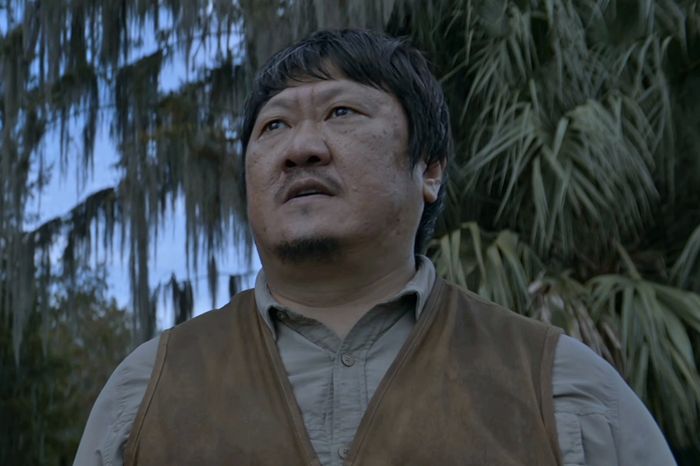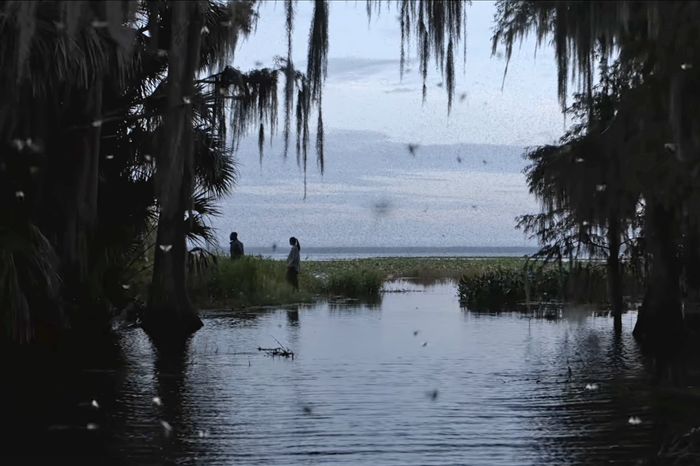
Spoilers follow for all eight episodes of 3 Body Problem on Netflix.
It’s the end of the world as we know it in 3 Body Problem, but by the end of the season, you’ll just feel fine. The Netflix adaptation of Liu Cixin’s novel includes the requisite elements of an alien-invasion narrative: all-powerful extraterrestrials, humanity’s greatest minds brought together to respond, their esoteric theories explained through simplistic diagrams for the science-challenged viewers among us. But the show’s system of storytelling rotates around a hollow core, its limited scope never profound enough to convince us that the human race is on the brink of extinction. It’s as if 3 Body Problem were so wary of overwhelming viewers with too much story that it preemptively held itself back, and that insufficient world-building culminates in the season’s final scene, when the bugs meant to represent humanity seem as small as the series’ imagination.
David Benioff, D. B. Weiss, and Alexander Woo’s take on The Three-Body Problem starts off by establishing that “science is broken” prompting scientists around the world to die by suicide. 3 Body Problem hyperlocalizes this catastrophe in the U.K., collapsing its scale to a couple of shadowy British government operatives (Benedict Wong’s deadpan investigator, Clarence, and Liam Cunningham’s high-ranking Wade) and the single friend group on which their investigation focuses: Auggie (Eiza González), Saul (Jovan Adepo), Jin (Jess Hong), Will (Alex Sharp), and Jack (John Bradley), a tight-knit crew of former star Oxford students mired in combative friendships and unspoken romantic tensions.
As the friends reunite to mourn their former mentor, physics professor Vera Ye, 3 Body Problem uses them to unfurl its central mystery. Jack and Jin begin playing an advanced virtual-reality game, supposedly left behind by Vera, about saving a race of people from a degenerating planet. Auggie sees a countdown whenever she opens her eyes. Saul is haunted by the atheist Vera wondering in her final moments whether God exists. Each episode reveals new ways these disparate pieces are tied together until halfway through the season, when the friends, Wade, and Clarence realize an alien race named the San-Ti are responsible for the mayhem, invited to Earth by Vera’s own mother, Ye Wenjie (Rosalind Chao), a Chinese woman convinced humanity was no longer worth protecting in the wake of the Cultural Revolution.
The discovery of the San-Ti and their intent to arrive on Earth in 400 years, as well Vera’s parents’ involvement with the aliens — including the murder of Jack on their behalf — nearly breaks the Oxford five apart. Saul responds with nihilistic, drug-induced disinterest, even as the San-Ti take over every screen on Earth to send humanity the message “You are bugs.” (It’s like Starship Troopers in reverse!) Jin joins Wade’s aggressive efforts to attack the San-Ti and protect the planet for their descendants. Auggie, having used her nanofiber research to help Wade murder hundreds of Wenjie’s followers to obtain critical information, can barely live with the violence of her decision. Meanwhile, lovelorn Will, dying of cancer, spends 19.5 million dollars buying a star for Jin before volunteering for the Staircase Project she’s working on with Wade, donating his brain to be rocket-launched into space, hopefully intercepting the San-Ti on their way to Earth.
By the time we get to the eighth episode, finale “Wallfacer,” that statistically impossible scheme involving a base on the moon, hundreds of nuclear bombs, and some wild math doesn’t work. Will’s ship veers so dramatically off-course that he won’t pass another star for 6,000 years. That’s not the only setback the anti-alien effort suffers: Auggie quits Wade’s team and takes her research with her, traveling to Mexico to install water-filtration systems for the needy, and Saul, chosen for a secret project affiliated with the United Nations’ Planetary Defense Council, is nearly assassinated by a San-Ti acolyte. As Jin and Saul mope by a motel pool following news of Will’s fate, Saul agrees with the San-Ti calling humans bugs — “We’re slow, we’re dumb, and we die easy” — and refuses any positivity when Clarence happens upon the pair: “Don’t give me a speech, man. I can’t take any Henry V bullshit.” But Clarence refuses to let the “two saddest-looking bastards I’ve ever seen” wallow and, in a scene that 3 Body Problem wants us to find rousing, drives Saul and Jin to a swamp on the outskirts of Cape Canaveral to prove his point.
Cicadas swarm the trio, the type of periodical brood emergence that occurs all over the East Coast; news reports had labeled the phenomenon just another nuisance to add to the “upcoming apocalypse” pile. Clarence doesn’t see them that way. He believes the bugs have qualities Saul and Jin need for their next effort to stop the San-Ti — durability, toughness. They know how to evade, persist, and survive, even as humans “spray pesticides from planes,” “put poison in the ground,” “try and sterilize ’em,” and “swat ’em, zap ’em, step on ’em,” Clarence says. As he delivers this speech matter-of-factly, the bugs zooming around, Saul and Jin steel themselves, their mouths set and eyes hardened into matching looks of determination. Bugs adapt, and humans will too.
In the scene’s concluding seconds, it switches to a wide shot with Clarence, Saul, and Jin mere silhouettes in the background and numerous bugs flying around the foreground. The humans are outnumbered, but they’re among allies. Despite Saul’s earlier sarcasm, Clarence’s speech plays out exactly like Henry V’s “Once more unto the breach” call to arms — an animal-kingdom comparison, an appeal to shared goals — and in doing so, emphasizes 3 Body Problem’s oversimplification. All of humanity’s hope is distilled into this trio; while Henry V had nationalism as an excuse for its small circle of interest, 3 Body Problem, in comparison, found it unnecessary to build any other nation’s response into this story about the entire world grappling with its potential end. That miscalculation ultimately undermines the show’s journey of despair and resilience.
It’s effective for 3 Body Problem to deny us information about the San-Ti, to build our fear and curiosity about what they look and act like based only on video-game renderings and foreboding conversations with Vera’s father, Mike (Jonathan Pryce). But in that absence, 3 Body Problem had an opportunity to emphasize the paranoia and panic felt by all of humanity — by children who must be taught about the San-Ti’s “Eye in the Sky” surveillance device, by astronauts monitoring for potential advance guards sent by the aliens, by employees at The Stars Our Destination, a nonprofit tasked with raising money for global defense. Forgoing that to pay exclusive attention to a teeny group of people diminishes the fear the series wants us to feel.
We need a wider lens to understand just how much is at stake. How did Wade end up in charge of the global response, who are his colleagues, and how did they get their positions? How disparate is the international response — are other countries working on their own alliances and side deals with the San-Ti? Ye sided with the aliens because of the failure of the Cultural Revolution, but what about the other revolutionary nations and regions around the world? Do they have their own versions of Ye, their own leaders who think the world might be better under the San-Ti than our current systems of imperialism and capitalism? What are regular people doing — or are they too busy trying to survive these systems to do much about their existential gloom? Have they taken a stand against the absurdity of The Stars Our Destination, which asks for philanthropy from the world’s proletariat but surely could be funded by billionaires? Where are those billionaires anyway? Going underground, A Murder at the End of the World style, or decamping to Mars, For All Mankind style? Or actually doing something to help Earth’s commoners, a scenario for which I can name no TV comparison because it’s so rare?
3 Body Problem didn’t need to zoom around the globe in every episode or deviate too much from its core crew. But relying on only quick asides — news segments about cults popping up to worship the San-Ti, brief mentions of collaboration (or lack thereof) with the European Council for Nuclear Research and Iran — deny the narrative depth and fullness. The series so fully silos off its characters that the rest of its world-building falls out of alignment and overestimates our interest in this cohort of physicists as the most superspecial people in the entire world.
One of the series’ most evocative images has nothing to do with these friends, their cloistered lives, or their repetitive intragroup tensions. In the sixth episode, after the San-Ti send their “You are bugs” transmission to Earth, Clarence comes upon a waterway flanked by streetlights in a long parallel line, a body hanging from each. They sway slightly in and out of the lights’ illumination, as if, in a moment of insect-inspired shared cognition, this group of people decided to end their lives all at once rather than face the San-Ti’s threat. It’s disturbing, vivid, only a minute or so long, and much more incisive than the series’s climactic cicadas in conveying the ramifications of the San-Ti’s existence because it’s the rare instance 3 Body Problem considers perspectives beyond those of its core characters. “Wallfacer” literally ending with three bodies meant to represent all of humankind, suggesting that their experiences are enough to communicate a whole world of feeling, is a myopic problem of the series’ own making.
More From ‘3 Body Problem’
- The Best TV Valleys of 2024
- 3 Body Problem Is Not Afraid to Be TV
- 3 Body Problem? More Like Two More Seasons



